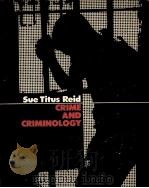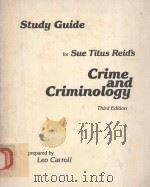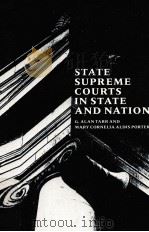《CRIME AND CRIMINOLOGY》
| 作者 | SUE TITUS REID 编者 |
|---|---|
| 出版 | THE DRYEN PRESS |
| 参考页数 | 740 |
| 出版时间 | 没有确切时间的资料 目录预览 |
| ISBN号 | 0030891817 — 求助条款 |
| PDF编号 | 812224418(仅供预览,未存储实际文件) |
| 求助格式 | 扫描PDF(若分多册发行,每次仅能受理1册) |

PART ONE Introduction to the Study of Crime1
1 Crime, The Criminal, and Criminology3
The Concept of CrimeHistorical Meaning of Crime4
Legal Definition of Crime5
Crime is an Intentional Act or Omission5
In Violation of Criminal Law9
Committed without Defense or Justification12
Sanctioned by the State as a Felony or Misdemeanor14
Judge or Jury as Final Determiners of a Crime15
Nonlegal Definitions of Crime16
Definition of Criminal17
Definition of Delinquency19
Meaning of Criminology21
Recommended Readings22
2 Concept and Purpose of Law24
The Nature of Law25
Flexibility25
Stability: The Principle of Stare Decisis26
Methods of Social Control Informal Social Control:Small, Cohesive Human Groups28
Need for Formal Social Control in Complex Human Societies28
Law as a Form of Social Control29
The Importance of Law30
The Limits of, Law31
Control of Morality by Law Debate over the Control of Morality by Law32
Relationship of Law, Sin, and Morality Historically33
Distinction Between Mala in se and Mala Prohibita Crimes Overcriminalization in the Law34
Criminalization of Crimes without Victims: Functional or Dygfunctional40
Definition of Victimless Crimes Laws Cannot Change Mores41
Functions of Laws Regulating Moral Behavior42
Dysfunctions of Laws Regulating Victimless Crimes43
Purposes of Criminal Law45
Recommended Readings46
3 Measurement of Crime in the United States47
The Uniform Crime Reports Categories of Crimes48
Extentof Crime in the United States Crime as Measured by the Uniform Crime Reports49
Crime as Measured by Anonymous Questionnaires50
Crime as Measured by Interviewing Techniques55
Demoaphic Characteristics of Persons Arrested for Crimes56
Sex58
Age Race59
Victims of Crime62
Analysis of Official Crime Statistics Reporting Methods72
Crimes Not Included in the Official Statistics74
New Perspectives75
Recommended Readings78
4 Research in Criminology79
Causation Meaning of Cause80
Legal Meaning of Cause81
Research Methods Longitudinal Studies82
Cross-Sectional Approach91
Armchair, or Theoretical, Approach92
Purpose and Nature of Scientific Research93
Fact and Theory Concepts93
Errors in Methodology Definition of Terms94
Sampling Errors Lack of Control Groups96
Lack of Follow-up Studies97
Logic-of-Science Errors Dualisticfallacy99
Ability of the Theory to Identify the Crime Predictability99
PART TWO Theories of Criminal Behavior101
5 Classical, Neoclassical, and Positive Theories103
Historical Background of Punishment and Criminal Law104
Conditions in France105
Conditions in England106
Classical School Cesare Beccaria107
Jeremy Bentham110
Principle of Utilitarianism111
Neoclassical School113
Positive School114
Cesare Lombroso115
Raffaele Garofalo121
Enrico Ferri125
Comparison of the Classical and Positive Schools128
6 Physiological, Psychiatric, and Psychological Theories130
Physiological Theories Phrenology131
Endocrinology132
Class-Linked Social and Environmental Factors and Physiological Differences Theories of Ernest Albert Hooton133
Heredity Theories136
Body Type Theories143
Biopsychosocial Theories147
Other Theories Evaluation of the Physiological School149
Psychiatric and Psychological Theories150
Historical Background151
Psychiatric Approach152
So io athic Personality161
Evaluthe Physiological, Psychiatric, and Psychological Theories164
Legal Reactions to Physiological, Psychiatric, and Psychological Theories165
Sterilization Laws166
Sexual Psychopath Laws168
Insanity Plea Defense169
Recommended Readings171
7 Sociological Theories of Causation: Social Structural Theories172
Economic Conditions and Crime173
Contributions of Emile Durkheim175
RobertMerton’s Theory of Anomie176
Modes of Adaptation177
Evaluation of Merton’s Theory180
Subculture Theories181
Thrasher’s Study of the Gang Coheh’s Middle Class Measuring Rod181
Matza’s Theory of Delinquency and Drift Sykes and Matza’s Techniques of Neutralization184
Cloward and Ohlin’s Theory of Differential Opportunity186
Miller’s Lower Class Boy and Lower Class Culture189
Evaluation of Subculture Theories190
Ecological Theories191
Evaluation of the Ecological School192
Culture Conflict Theory194
Evaluation of Culture Conflict Theo195
Racial Theories196
Home Environment and Crime197
Modern Conflict Theories199
Conflict and Functionalist Theories Compared200
Conflict over Power and Authority201
Contributions of Richard Quinney to Conflict Theo202
Evaluation of Conflict Theories203
Other Social Structure Theories Evaluation of Social Structural Theories205
Recommended Readings207
8 Sociological Theories of Criminal Behavior: Social Process Theories208
Gabriel Tarde209
Theory of Imitation210
Edwin H.Sutherland Theory of Differential Association211
White-Collar Crime217
Self-Concept and Containment Theory227
Evaluation of the Self-Concept and Containment Theo229
Labeling Theory231
Empirical Evidence234
Evaluation of Labeling Theory235
Evaluation of Social Process Theories Conclusion to Sociological Theories238
LegalSocial Control Perspective240
Criminal Behavior Systems241
Behavior Systems in General242
The Development of Deviant Careers243
A Typology of Criminal Behavior Systems244
Characteristics of Criminal Behavior Systems248
Recommended Readings251
PART THREE The Criminal Justice System253
9 Overview of the Criminal Justice System255
Stages in the Criminal Justice System Investigation Prior to Arrest Booking Initial Appearance256
Preliminary Hearing Information Grand Jury Indictment Arraignment257
Reduction of Charge System and Process260
Concepts of American Criminal Justice The Adversary System versus the Inquisitorial System261
Disadvantages266
Due Process and the Rights of the Defendant269
Analysis of the System of Criminal Justice289
Sociology of Law290
The Poor and the Legal System298
Minorities and the System of Criminal Justice300
Recommended Readings303
10 The Police305
History of the Police System307
Profile of the Role of Police The Policeman as Law Enforcer308
Allocation of Police Time311
Background and Characteristics312
Role Conflicts314
“Judicial Leniency” as Seen by the Police Police Discretion321
Police Physical Violence and Brutality324
Politicization of the Police and the Need for External Control328
Suggestions for Improving the Police Force Training, Education, and Salaries330
Reorganize the Police Role336
Redesign the Job of Patrolman337
Recommended Readings342
11 Detention and Short-Term Treatment343
The Bail System History344
Purpose of Bail346
Effect of the Bail System on the Defendant348
Bail Reform351
Pretrial Detention354
Jails History of Jails358
Organization and Use of Jails360
“Modern”Jails in the United States361
1972 Survey of Jails365
Federal Court Findings on Jail Conditions367
Suggestions for Improving Jails372
Alternatives to Jail373
Recommended Readings374
12 The Role of Lawyers and Judges375
Historical Role of the Lawyer376
Legal Education377
Legal Ethics and the Formal Control of Lawyers378
Organizational Structure of the Legal Practice380
Prosecution and Defense Prosecuting Attorney382
Defense Attorney386
Defender and Prosecutor: A Case of Accommodation?391
Judges Judicial Training394
Selection of Judges396
Judicial Decision Making Process398
Hogarth’s Study of Sentencing402
Sentencing Process405
Types of Sentences406
Who Should Sentence407
Sentencing Disparity415
Recommended Readings421
13 The Court System423
Criminal Court System Legal Terms and Concepts424
Process of Judicial Review426
The Dual Court System427
Lower Courts428
United States Supreme Court440
Juvenile Court448
Background and History449
The Philosophy of the Juvenile Court450
Reality of the Juvenile Court453
Impact of Gault upon Juvenile Court Philosophy458
Recommendations for Change461
Recommended Readings463
PART FOUR Social Reaction to Crime: Corrections465
14 Punishment467
Corporal Punishment Historically Mutilation and Branding468
Ducking Stool Psychological Punishment and Social Disgrace469
Exile and Banishment Transportation470
Flogging471
Capital Punishment Historical Overview473
Statistics on Capital Punishment Methods of Capital Punishment476
Death Penalty Debate480
Justifications for Punishment492
Incapacitation494
Reparation Maintenance of Social Solidarity495
Retribution496
Individual Deterrence General Deterrence499
Differential Implementation of Punishment Theories of Punishment504
Cultural Consistency Psychoanalytic Theory Social Structure Theories505
How Much Punishment:A Debate506
Cruel and Unusual Punishment507
Recommended Readings510
15 Prison: The Alternative to CorPoral Punishment512
Historical Development513
John Howard: The Great Prison Reformer514
Emergence of the Penitentiarv in America The Development of the Pennsylvania System515
Development of the Auburn System517
Comparison of the Pennsylvania and Auburn Systems518
Emergence of the Reformatory System519
Prison Architectur Historical Overvlew520
Penal Philosophies Reflected in Prison Architecture523
Brief Look at the “Modern” American Prison528
Prison as an Alternative to Corporal Punishment530
Arkansas Prison System531
Noncorporal Punishments534
Prison Riots537
Recommended Readings548
16 The Modern Prison: Progress Toward Treatment and Rehabilitation549
Typology of Treatment Forms550
Psychological Therapies551
Environmental Therapy557
Examples of Prison Treatment Programs ROARE559
The Washington Program560
Adjuncts to Prison Treatment Programs Prison Administration561
Functions of Prison Personnel562
Guard-Inmate Relationships563
Improvement of Guard-Inmate Relationships564
Classification568
Types of Systems570
Ideal System572
Contribution of Classification573
Prison Education Academic Programs574
Vocational Training:Prison Labor and Indust578
Work Release and Furlough Programs582
Advantages Disadvantages584
Release Procedures Historical Overview585
Prerelease Programs586
Recommended Readings589
17 The Prison Community591
Inmate Social System: Male Prison Community592
Inmate Codes593
The System as an Agency of Social Control595
Forms of Social Control596
Socialization into the System600
Social Roles600
Female Prison Community606
Contrast with Male Prison Community607
Sexual Problems609
Homosexuality610
Conjugal Visits614
Furloughs619
Recommended Readings621
18 Alternatives to Confinement622
Probation and Parole Historical Overview623
Use of Probation and Parole624
Organization of Probation625
Organization of Parole626
Services Provided for the Probationer and Parolee628
Parole and Probation Officers629
Conditions of Probation and Parole630
Evaluation of Probation and Parole633
Suggestions for Reducing Recidivism637
Granting of Parole and Probation639
Revocation of Probation and Parole644
Shock Probation and Shock Parole647
Community Treatment Programs Guided Group Interaction Programs649
Foster and Group Homes651
Halfway Programs: Prerelease Guidance Center653
Intensive Community Treatment654
Reception Center Parole655
Other Programs656
Examples of Community Programs657
Detoxifiication and Diagnostic Center658
Recommended Readings662
19 Constitutional Rights of Prisoners664
Hierarchy of Rights665
Visitation Privileges666
Visitation Rights with the Press667
Right to the Use of the Mails668
PrisonDiscipline Use of Force Corporal Punishment671
Solitary Confinement672
Disciplinary Hearing675
Medical Treatment677
Right to Medical Treatment678
Constitutional Right to Treatment680
Right Not to be Treated682
Right of Access to the Courts683
Recommended Readings685
20 Reformation of the Criminal and the Prison: Some Problems687
Recidivism688
Measuring Recidwism Rates690
Comparing Studies pf Recidivism Rates691
Prediction692
History of Prediction Tables693
Requirements of Pre iction Tables The Gluecks’ Prediction Scale694
Other Prediction Tables695
Correctional Research Administrative and Treatment Personnel Attitudes696
Isolating the Treatment Variable697
Defiining “Success”698
Role of the Evaluation Researcher Methodology699
Evaluation of a Specific Treatment Program700
Prison Reform Obstacles704
Means705
Federal Prison System711
European Prison Systems Denmark712
Finland The Netherlands Sweden713
Future of Corrections715
Recommended Readings717
Index719
《CRIME AND CRIMINOLOGY》由于是年代较久的资料都绝版了,几乎不可能购买到实物。如果大家为了学习确实需要,可向博主求助其电子版PDF文件(由SUE TITUS REID THE DRYEN PRESS 出版的版本) 。对合法合规的求助,我会当即受理并将下载地址发送给你。
高度相关资料
-

- Crime and Criminology An Introduction
- 1996 Oxford University Perss
-

- CRIME AND INSANITY
- WILLIAMS AND NORGATE
-

- CRIMINOLOGY AND JUSTICE
- 1994 MCGRAW HILL INC
-

- FEMALE CRIME THE CONSTRUCTION OF WOMEN IN CRIMINOLOGY
- 1987 NGAIRE NAFFINE
-

- Crime and Punishment
- 1982 A BANTAM SKYLARK BOOK
-

- FEMINISM AND CRIMINOLOGY
- 1997 POLITY PRESS
-

- CRIME AND CAPITALISM READINGS IN MARXIST CRIMINOLOGY
- 1993 TEMPLE UNIVERSITY PRESS
-

- STUDY GUIDE FOR SUE TITUS REID'S CRIME AND CRIMINOLOGY
- 1982 RINEHART AND WINSTON
-

- INSTRUCTOR'S MANUAL AND TEST BANK FOR SUE TITUS REID'S CRIME AND CRIMINOLOGY
- 1982 NEW YORK CHICAGO SAN FRANCISCO
-

- WOMEN AND CRIME
- 1985 NEW YORK UNIVERSITY PRESS
-

- STATE SUPREME COURTS IN STATE AND NATION
- 1988 YALE UNIVERSITY PRESS
提示:百度云已更名为百度网盘(百度盘),天翼云盘、微盘下载地址……暂未提供。➥ PDF文字可复制化或转WORD



